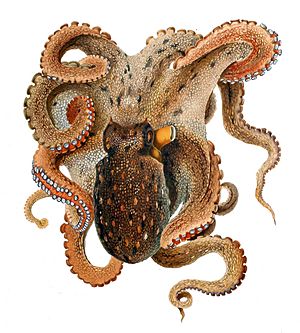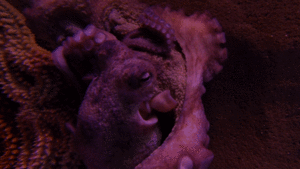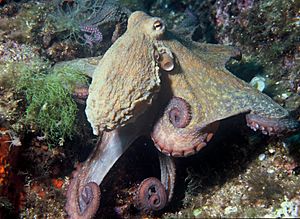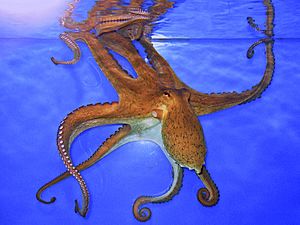Common octopus facts for kids
Quick facts for kids Common octopus |
|
|---|---|
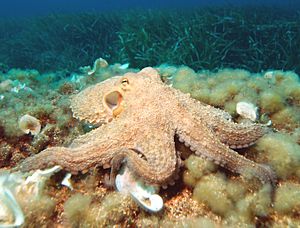 |
|
| Conservation status | |
| Scientific classification | |
| Synonyms | |
|
The common octopus (Octopus vulgaris) is a fascinating sea animal. It belongs to a group called molluscs, which also includes snails and clams. This octopus is the most studied of all octopus kinds. You can find it all over the world, from the eastern Atlantic Ocean, including the Mediterranean Sea and near England, all the way to South Africa. It also lives near the Azores, Canary Islands, and Cape Verde Islands. You can find it in the Western Atlantic, too.
Common octopuses usually hunt when the sun goes down. They love to eat crabs, crayfish, and clams (which are bivalve molluscs with two shells). But they will eat almost anything they can catch! This amazing creature can change its color to hide perfectly in its surroundings. It can also quickly pounce on any unsuspecting prey that comes too close. The octopus uses its strong beak to break open the shells of its prey. Scientists have even shown that common octopuses can tell the difference between how bright, big, or shaped objects are, and if they are standing up or lying down.
Contents
What makes the Common Octopus special?
The common octopus can grow quite large. Its body (called the mantle) can be about 25 centimeters (10 inches) long. Its arms can stretch up to 1 meter (3 feet) long! These octopuses usually live for a couple of years. They can weigh up to 9 kilograms (20 pounds). Many common octopuses are caught by fishing boats, especially off the coast of northwestern Africa. More than 20,000 tonnes are harvested each year.
Besides changing color, the common octopus has another secret weapon: venom! It uses this venom to help calm down its prey.
These octopuses have developed very large nervous systems and brains. An individual octopus has about 500 million neurons, which is almost as many as a dog! They are smart enough to tell different brightness levels apart. They can also find their way through mazes and even recognize individual people. Some have learned how to unscrew a jar or even sneak into lobster traps to get food. The common octopus was the first invertebrate (an animal without a backbone) to be protected by a special law in the UK. This law helps protect animals used in scientific studies.
How does the Common Octopus live?
Where do they live?
The common octopus lives in warm and mild waters all over the world. They like to stay on the bottom of rocky, coastal areas that are not too deep. Usually, they are found in waters no deeper than 200 meters (656 feet). They prefer water with a certain amount of salt, but they can live in areas with slightly more or less salt.
The best temperature for them is around 15 to 16 degrees Celsius (59 to 61 degrees Fahrenheit). If the water gets too warm, octopuses often go deeper to find cooler layers. When an octopus moves up and down in the water, it experiences different pressures and temperatures. These changes affect how much oxygen is available in the water.
How do they breathe?
Octopuses breathe using gills, similar to fish. Their gills are specially designed to take in a lot of oxygen from the water. Water slowly moves over the gills, into a space called the mantle cavity, and then out through a tube called the funnel.
The common octopus can take in a lot of oxygen, up to 65% of the oxygen in the water. Even their skin helps them breathe! When resting, about 41% of their oxygen comes through their skin. This amount changes when they are active. When swimming, more of their body is exposed to water, but the skin's share of oxygen absorption actually drops to 33% because swimming uses a lot of energy. If the octopus is curled up after eating, its skin might only absorb 3% of the oxygen.
Octopuses have a special blue blood pigment called hemocyanin. This helps them pick up oxygen. They can keep taking in oxygen even if the oxygen levels in the water drop a bit. If oxygen levels in the sea water get very low (1-10%), it can be dangerous for them. To get more oxygen, they can pump more water over their gills. This helps them save energy and live in places where oxygen might be scarce.
Water enters the octopus's mantle cavity and touches the gills. The water has more oxygen than the octopus's blood, so oxygen moves into the blood. The octopus's body uses this oxygen and releases carbon dioxide. The gills have many small folds with tiny blood vessels. This increases the surface area where oxygen can enter the blood. This design allows oxygen to move quickly and easily into the blood.
How does their blood move?
The octopus has three hearts! It has one main heart with two chambers that sends oxygen-rich blood to its body. It also has two smaller hearts, called branchial hearts, one next to each set of gills.
Here's how the blood moves:
- Oxygen-rich blood from the gills goes to the main heart.
- The main heart pumps this blood to the rest of the body.
- Blood that has used its oxygen goes to the two smaller branchial hearts.
- These branchial hearts pump the blood through the gills to get more oxygen.
- Then, the newly oxygenated blood goes back to the main heart to start the process again.
The octopus's blood is blue because it contains a copper-rich substance called hemocyanin. This is different from human blood, which is red due to iron-rich hemoglobin. Hemocyanin is not as good at carrying oxygen as hemoglobin. This means octopuses can get tired quickly if they move very fast.
The octopus's blood vessels are very stretchy, like rubber bands. They are made of a special elastic fiber. This helps the blood flow smoothly from the heart.
How do they handle salt and water?
The fluids inside an octopus, like its blood and urine, have the same saltiness as the surrounding seawater. This means octopuses don't actively control their internal salt levels like some other animals do. They simply match the saltiness of their environment. If there's too much fresh water in their environment, it can be deadly for them.
However, octopuses do control some specific salts (ions) in their bodies. For example, they keep lower levels of sodium, calcium, and chloride inside their bodies compared to seawater. This suggests they can actively remove certain ions to keep their bodies balanced.
The common octopus has a kidney system that is very different from ours. It helps filter their blood and remove waste. These kidneys also put important things like sugar and amino acids back into the blood. They also adjust the salt levels in their urine and add waste products. Once the urine is ready, it's released into the octopus's mantle cavity.
Octopuses produce heat from normal body processes, like digesting food. But they don't have special ways to keep their body temperature within a certain range. Their body temperature quickly matches the temperature of the water around them. They prefer temperatures between 13 and 28 degrees Celsius (55 to 82 degrees Fahrenheit). Their best temperature for using energy efficiently is around 20 degrees Celsius (68 degrees Fahrenheit).
If the water gets warmer, the octopus uses more oxygen. This is because its body processes speed up. If it gets too hot, the octopus might not be able to get enough oxygen, which can be dangerous. To stay comfortable, octopuses might swim to shallower or deeper waters to find their preferred temperature zone.
Images for kids
See also
 In Spanish: Pulpo común para niños
In Spanish: Pulpo común para niños



